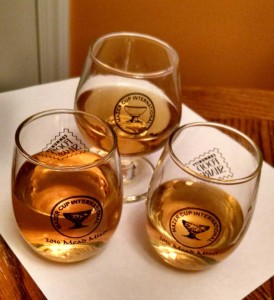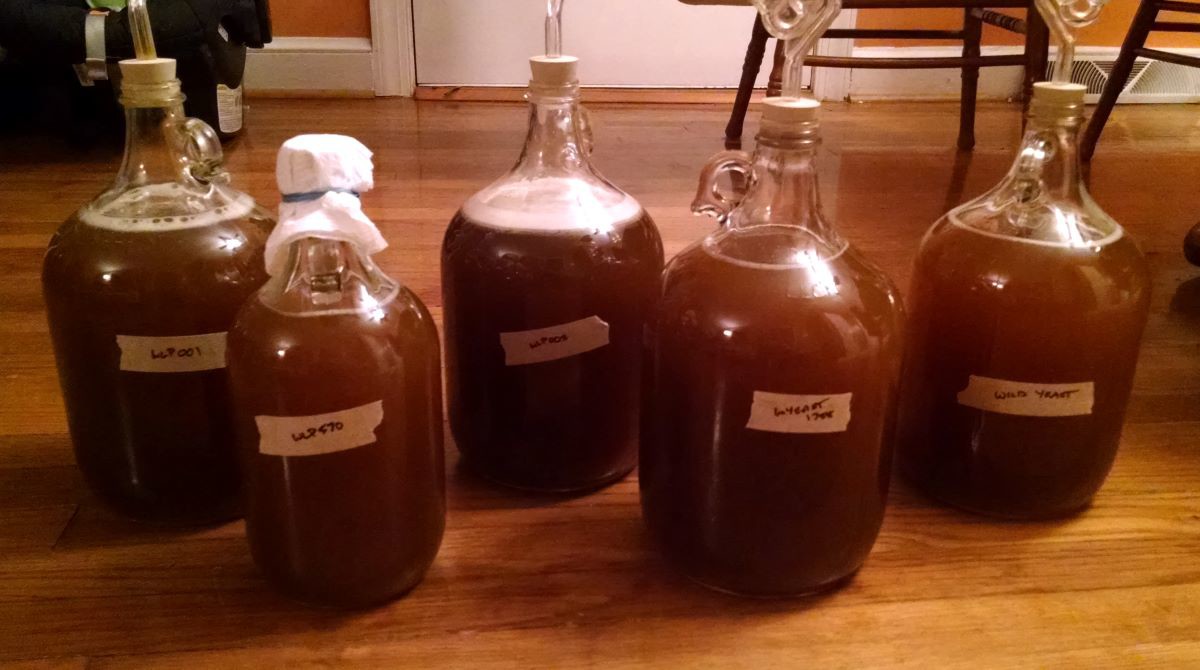In Episode 34 we bring you news that Billy Beltz, recent 2 time medal winner at the Mazer Cup 2016, completed the Great Mead Ale Yeast Experiment. With 12 different yeasts, his experiment was pretty comprehensive from a study perspective and provides another data point considering how and when to use an ale yeast in mead. The full story will come out in the next Zymurgy Magazine, but for now here is a preview of what’s to come.
Right click here to download the mp3 directly.
Drinks in This Episode
-

WLP001, WLP002, and Wyeast 1388 from Allen’s Experiment Allen and Tysen: Traditional mead (Shenandoah wildflower honey) fermented with WLP001, WLP002, WLP570 and Wyeast 1388
- Billy: Traditional mead (California wildflower honey) with WLP001, WLP002, WLP041, and Wyeast 1388
The Experiment Specifics
Yeasts
- WLP001: California Ale Yeast (White Labs)
- WLP002: English Ale Yeast (White Labs)
- WLP004: Irish Ale Yeast (White Labs)
- WLP007: Dry English Ale Yeast (White Labs)
- WLP028: Scottish Ale Yeast (White Labs)
- WLP041: Pacific Ale Yeast (White Labs)
- WLP300: Hefeweizen Ale Yeast (White Labs)
- WLP500: Monastery Ale Yeast (White Labs)
- WLP545: Belgian Strong Ale Yeast (White Labs)
- Wyeast 1388: Belgian Strong Ale Yeast
- Wyeast 3711: French Saison Ale Yeast
- Lalvin 71B: Narbonne White Wine Yeast
Note, the following yeasts have been previously tested by Billy and were not included in this experiment: WLP013, WLP023, WLP 051, WLP080, WLP090, WLP510, WLP530, WLP590, and WLP644.
Nutrients
Billy followed a staggered nutrient protocol with a total of 350 ppm YAN. The first dose was done at yeast pitch to provide some starting nutrients for the liquid yeasts. This was a Fermaid O only dose, as DAP can be toxic in the first stages of fermentation. The remaining doses at 24, 48, and 72 hours included Fermaid O, Fermaid K, and DAP. In total, the amount of YAN provided by each nutrient was roughly 1/3 of the total 350 ppm YAN.
Temperature
The yeasts for Billy’s experiment were fermented in a chamber held between 66 and 68 deg F.
Links in This Episode
Got your own Mead Ale Yeast Experiment going?
Are you running your own version of a mead ale yeast experiment? We’d love to hear about it. Ping us in the comments below or hit us up on social media at #Meadcast! You can find Allen @MeadMakr and Tysen @MeadDrinkr.
In two weeks we’ll be back with Matt from Laurel Highlands Meadery to hear about his bochet making practices as a commercial brewer.

Pretty cool. I used WLP001 and WYeast 3711 before.
Right now I’m also curious to try using some lager yeast (with lager making method).
Hey Pavel- I’d love to hear how that goes. I have a lager yeast test going right now with WLP810… I’ll let ya know how it turns out!
Let us know how it turns out. I may have to do a side by side comparison for lager yeasts too. Maybe we can work out a cross country comparison and get some bottles to each other to sample.
Great episode, guys–this is a great resource for jumping off into the world of meads made with beer yeast. My own experience along these lines is a recent WLP570 experiment, which seems to have turned out more pleasantly than yours–i.e., few or no band-aid-like phenolics–but which was also quite weird.
It’s a wildflower semi-sweet at about 12% abv with 13 points of residual sugar–it smelled of root beer during fermentation, but this turned into more of a bubble gum and pear aroma, with silky, buttery, Chardonnay-like textures with pear and Viognier/Chardonnay-like flavors in the finished product. Still hasn’t cleared and still has a slight yeasty note, but it’s only about 3 months old at this point so…we’ll see.
While not a cider, this is probably the best example I’ve found of ‘pure band-aid juice’, though it’s actually quite amazingly good despite all that (at least to my palate):
http://cidersage.com/cider-review-bittersweet-funk-olivers-cider-perry/
Re: Bittersweet funk, I meant ‘while not a mead’, not ‘while not a cider’. Derp.
Thanks for the extra info about 570. I’ll have to open a bottle in a couple of weeks to do a more in depth analysis of the flavor. I recall some pear aroma during the ferment, but really wasn’t a huge fan at the end. It could have come down to temperatures too. Maybe the other yeasts didn’t mind the ramp up after my temperature controller broke as much as this one did.
And wait ’til you get the actual article. I didn’t want to steal all of Billy’s thunder, so I only included a few snippets in the show notes.
I’ve had good luck with WLP644 in making a mead with no off flavors, but it came out very tart after 3 months. At 1-2 months it was delicious. I’m making a 5 gallon batch right now to blend with an american golden strong ale. Going to try out a batch with WLP041 after reading about it in Zymurgy
After rereading the list and the results, I want to try 041 as well.
I’m curious if your 644 went tart from an infection. I don’t know why it would go tart otherwise.
I don’t think so. There were no discernable off flavors and I am getting pretty good at identifying them. White Lab’s website also says that it will create a slightly tart beer. At 3 months, the pH was 3.2 and the balance was lost. Still delicious, though. I think it will make a really refreshing braggot because it throws of lots of fruity esters and the tartness.
I’m going to be making my first metheglin (besides using vanilla and cinnamon) with 041. I’ll post my results on /r/mead. Using a ton of herbs, spices, and orange based on recipes from Jon Talkington (mead makers facebook group admin/DFH brewer/meadery startup).
Interesting. I’ll be on the lookout for the thread.